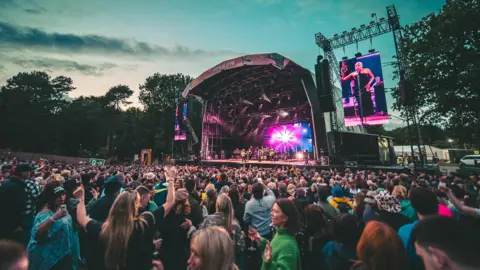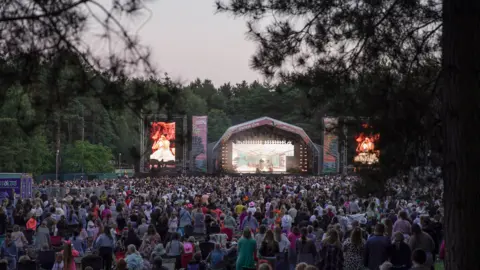How hard is it to stage a massive gig in a forest?
1 day agoShareSave
Alex McIntyre
BBC News, West Midlands

In 2001, the organisation responsible for England’s forests launched a concert series in a bid to increase funding and visitor numbers.
It was the brainchild of Mike Taylor, a manager at the Forestry Commission, now Forestry England, who had a “strong passion” for music and the outdoors.
In the 24 years since, Forest Live has become a mainstay of the music scene, with stars like Ed Sheeran, Massive Attack, Blondie, Madness and the Beach Boys performing among the nation’s trees.
This year’s gigs will be held in June at Cannock Chase Forest in Staffordshire, Delamere Forest in Cheshire, Westonbirt Arboretum in Gloucestershire and High Lodge, Thetford Forest in Norfolk.
Among the 2025 performers, which vary from venue to venue, are Sting, Snow Patrol, Gary Barlow, Nile Rodgers & CHIC, Rag’n’Bone Man and James.
But according to Rhodri Jones, Forestry England’s national events programme manager, staging the gigs was not an easy task.
“It’s a really challenging environment and requires a big transformation,” he said.
“The strengths and uniqueness of our sites are also what brings the greatest challenges.”

Getting people to the sites quickly and safely presented difficulties, Mr Jones said, as well as transporting and setting up the “considerable” infrastructure needed.
“It requires an enormous amount of planning by an incredibly skilled team to pull it all off,” Mr Jones said.
Then there’s the impact on the forests themselves – home to a vast array of animal and plant life, described by Mr Jones as a “constant consideration” for Forestry England.
He said the organisation made use of its in-house experts, who advise the teams on how to minimise impact on the environment.

“It would be counter-intuitive to present these concerts to protect and preserve the forest environments but do damage to them with the presentations themselves,” he said.
“Our sites are home to incredible wildlife and plant life and the concerts are presented to raise funds for the protection and conservation of the nation’s forests, so we must ensure that the concert operation does nothing to disturb the natural surroundings.”
Constructing the stages takes a team of about 50 people, which will grow to roughly 250 during show days.
With capacities at the venues ranging from 8,000 to 10,000 concert-goers, Mr Jones said working out entry and exit points for traffic, as well as emergency access, can prove challenging.
“We must ensure everyone can get to and from the rural settings, so we set our capacities in line with that,” he said.

Then there’s the English weather, with forests particularly vulnerable to extreme conditions like high winds and thunderstorms.
Mr Jones said Forestry England was always “alive to the dangers” of natural challenges and aware of what it needed to do to protect the public.
“High structures along with the trees are susceptible to extreme weather events, so we must be reactive to forecasts and be prepared to cancel a show and issue refunds if there is any danger to the public,” he said.
Tickets for the concerts start at between £50 and £60, with all money raised going towards maintaining forests across the country, contributing towards Forestry England’s efforts to plant 7m trees a year.
“The experience is one of complete disconnect from the pace and noise of modern life – and connection with music, nature and a sea of like-minded concert-goers,” Mr Jones said.
“By attending a concert, you are also investing in the future of these incredible spaces, as the funds raised go towards preserving the nation’s forests for generations to come.”
Follow BBC Stoke & Staffordshire on BBC Sounds, Facebook, X and Instagram.


